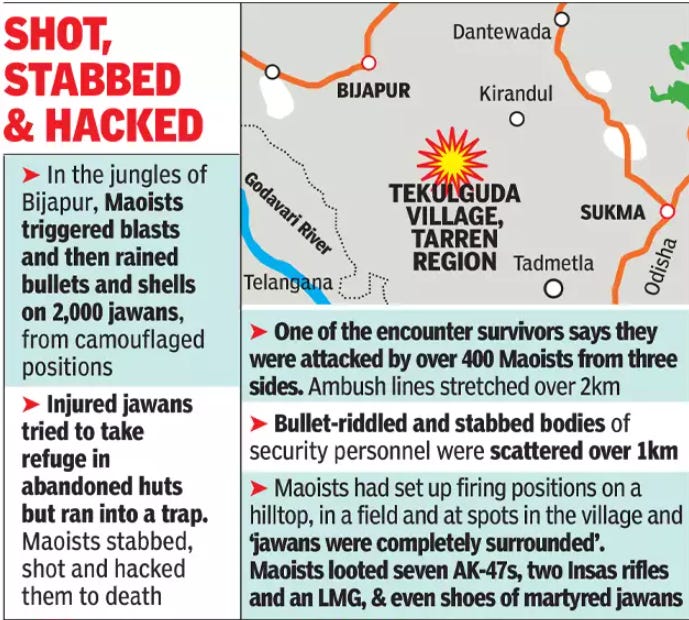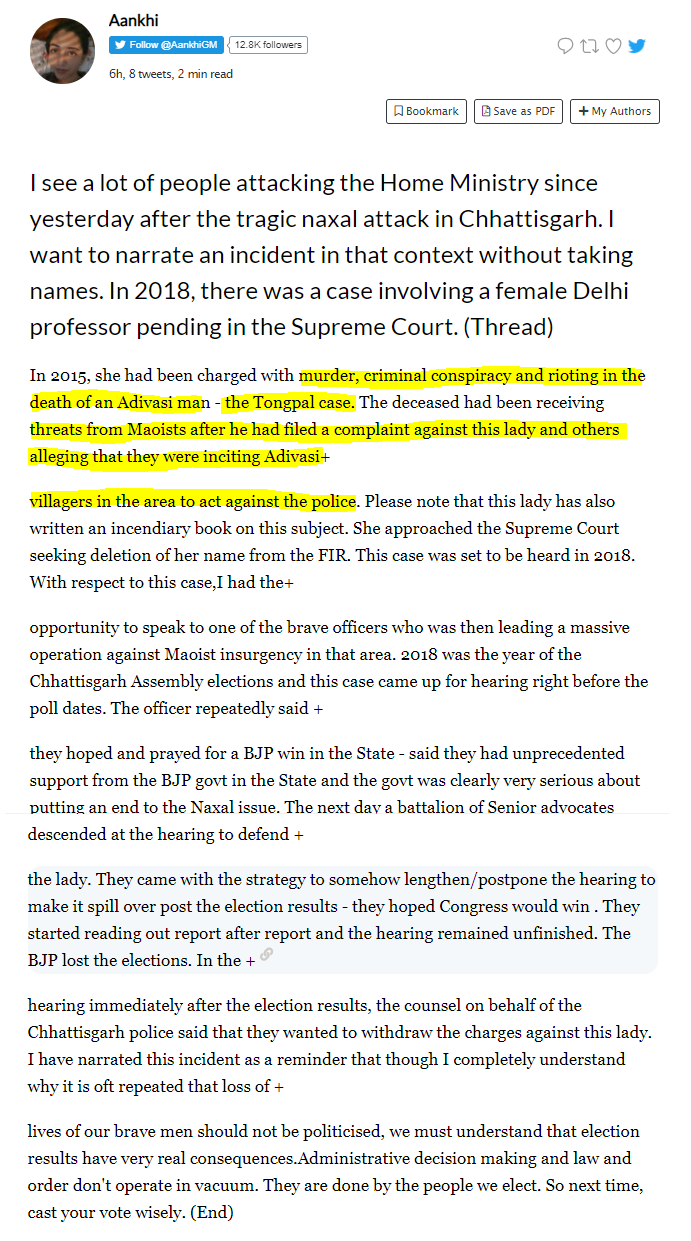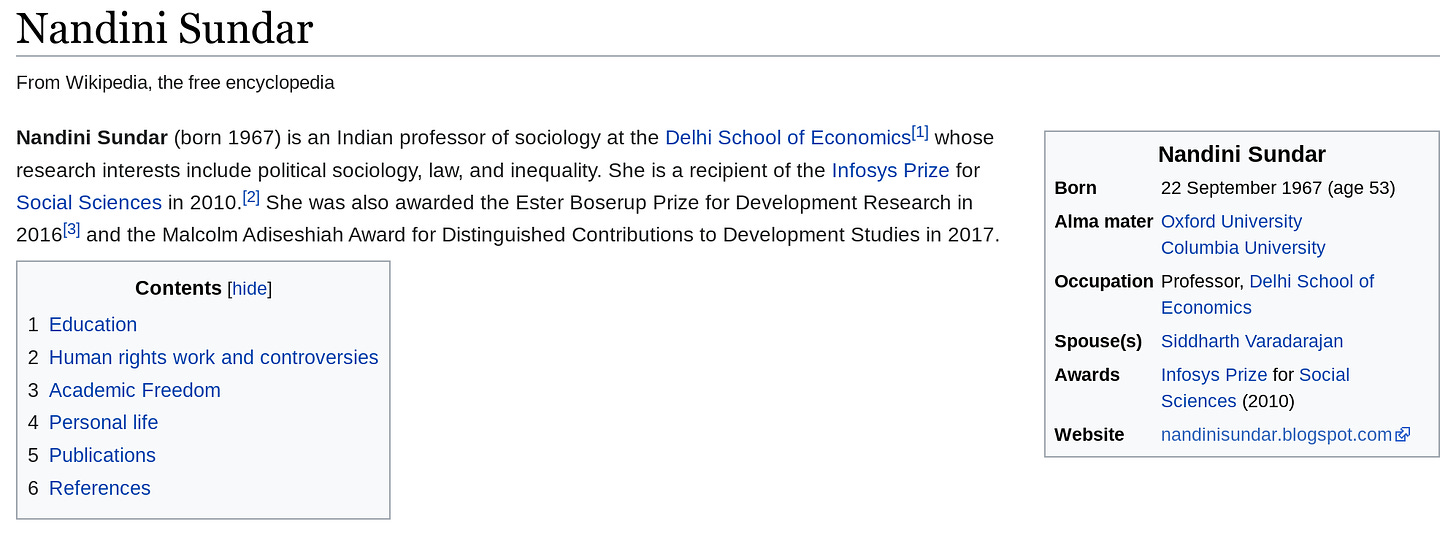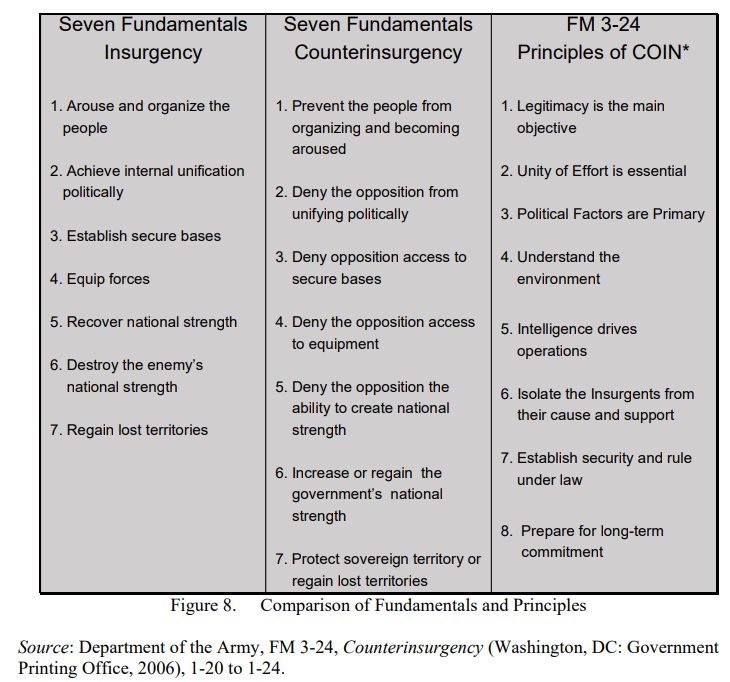Insightful newsletter of Drishtikone: Issue #278 - The Naxal Curse
It is a game of power paved with blood. Anyone who tells you anything else is an accessory to the mass murder! We can learn from the past or get fogged by morals that aren't.
“The object of terrorism is terrorism. The object of oppression is oppression. The object of torture is torture. The object of murder is murder. The object of power is power. Now do you begin to understand me?” ― George Orwell, 1984
Shamnath Baghel, a resident of Nama village in the Sukma district was an Adivasi. He made a mistake. Tried to stop a few professors from top Universities in India to come and instigate his people to fight the police and state.
One night, November 4th, 2016, Maoists barged into his home, dragged him, and killed him on the road.
And, then started a game that brought out all the players running a drama of death that is based on strategies perfected by a few madmen in the last century - Lenin, Marx, and Mao.
We are paying for their ruthless lust for power. The ways they perfected are used and followed by the forces which are the consequences of those violent ways. What they used in their game of blood at home, they have exported abroad.
It is not about the poor or the downtrodden. Between a Delhi University professor with an elite upbringing and choicest of awards and an Adivasi, it is very hard to miss the real victim. But a movement that supports and saves its “political infrastructure” at any cost, the Adivasi was the enemy. Somehow.
The attack in Chattisgarh
Communist Party of India (Maoist)’s guerrilla force called People’s Liberation unleashed an ambush terror attack in Chhatisgarh on CRPF and Chhattisgarh police.
In Saturday’s ambush, Maoists triggered blasts and then rained bullets and shells on the troops from well-camouflaged positions, inflicting heavy causalities. One of the survivors of the encounter said that they were attacked by over 400 Maoists from three sides. The ambush lines stretched over 2km near Tekulguda village. Running gunfights broke out near Tekulguda, Jonaguda and Jeeragaon villages as the forces fought back hard to break out of the ambush. (Source)
When some jawans took their injured soldier friends to the deserted Tekulguda village, the Maoists attacked them with daggers.
Here is an infographic from the Times of India. (Source)
As expected, while some are normalizing it on the left, most are not even commenting.
Mao and his bloody ways
Before we analyze the situation in India, let us get a handle on the Naxal/Communist insurgency and terror strategies and what Mao Zedong shaped the process.
The delegates of 81 Communist and Workers’ Parties decided in December 1960 (Source) that the tempo of “wars of liberations” will be energized and within a month Soviet Premier Nikita Sergeyevich Khrushchev shared his thoughts on this.
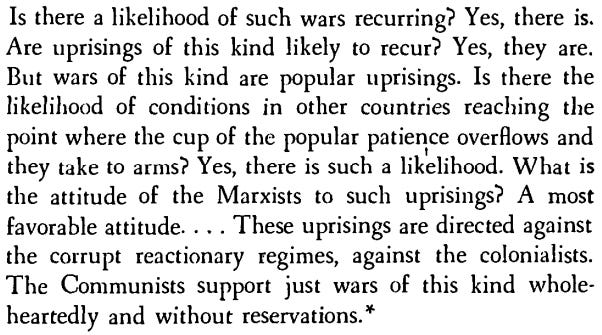
The verdict was clear.
Two types of insurgency-led communist terror tactics emerged - Conspiratorial and Mobilizational. Soviets (Leninists) mastered the former, while the Maoists mastered the mobilization. Regardless, both types go through 4 phases: propaganda, terrorism, guerrilla warfare, and mobile warfare.
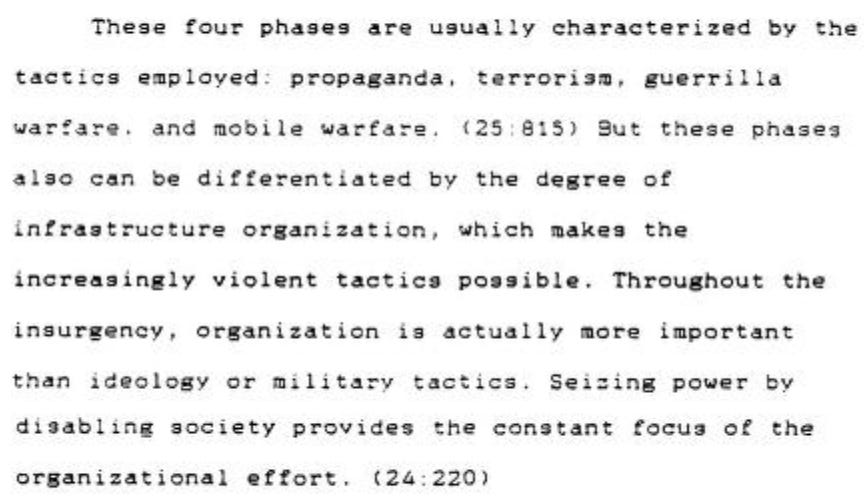
Mao Zedong was a master at using insurgency and guerrilla warfare. Jordan Beauregard, a U.S. Defense Intelligence Agency intelligence officer writes on Wavell Room, a military magazine, regarding Mao.
Mao is the master of war on insurgency, a style of warfare in which front lines and divisions between combatants and civilians are malleable. In insurgencies, the offensive and defensive tactics are less structured and the conflicts are often protracted, drawn out and designed to destroy the enemy’s will to fight. The aim is to create such disruption in the stronger, counterinsurgency force’s operating environment that the stronger force relents. In these cases, insurgent forces don’t necessarily have to win the war; they just don’t have to lose. However, in Mao’s case, eroding the “counterinsurgent’s” will to fight provides an opportunity to leverage conventional military tactics to defeat the stronger enemy outright. (Source)
In his own writings “On Guerrilla Warfare”, Mao laid down 7 fundamental steps to be successful in the political goals of insurgency. These have been altered and perfected over time.
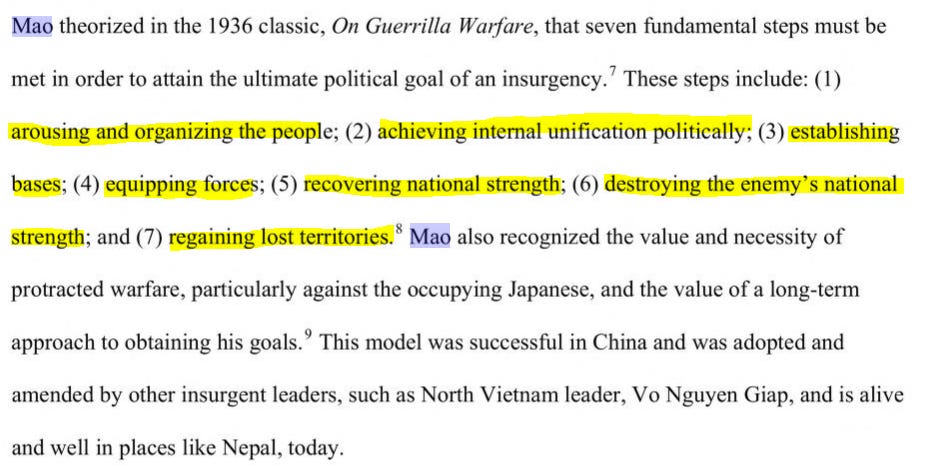
People’s War or insurgency, Beauregard suggests, has three stages: (Source)
Strategic Defensive
Strategic Stalemate
Strategic Offensive
In the first stage of strategic defensive, the insurgent force works on remote areas where the state’s influence is the least. This stage is accompanied by a military component such that the groups use irregular warfare tactics and guerilla warfare to take control. It is the time to lay the foundation. This stage is marked by smaller and targeted attacks as opposed to mass assaults.
The second stage of strategic stalemate is when the insurgents - after having won important battles and even territory start working on stronger military and political bases. The counterinsurgency force gets exhausted and it is this time when the insurgents establish legitimacy and strength.
In the third stage of strategic offense, the rag-tag group of insurgents now becomes a full-fledged fighting force. They are confident and strong enough to come out of the remote areas and take hold of larger cities and commercial centers.
The infrastructure and Naxals
An example of the third stage of preparedness is in this tweet below. This video was shared by an ex-Army officer, is Gul Panag’s father. Panag is from Aam Aadmi Party, a party that sympathizes with the Naxals and terrorists - and by the way, he gushes over the preparedness of the Maoists, shows how deep the insurgents have infiltrated the Indian state agencies.


For an insurgent, infrastructure is the key. The ‘center of gravity.’ The political and military infrastructure is what the Naxals protect at every cost. Later on, we will see how to save four ‘Urban Naxals’ - professors at top Indian universities, the entire machinery got active in Chattisgarh. They realize that in the end, it is the infrastructure that provides the discipline, helps in planning and breeds the leadership that is required for “success.” [DTIC ADA251855: U.S. Counterinsurgency Doctrine and Insurgent Infrastructures: Proscribed Failure? by Defense Technical Information Center (Source)]
Insurgencies can be categorized in three types based on their objectives: National liberation, Social Revolution, and Separatist movement.
The Indian independence revolutionaries like Bhagat Singh and friends worked on the first type and that is why they were so drawn to Lenin and the Communists.
The Indian ecosystem of Urban Naxals
How does the ecosystem of Urban Naxals and the Naxal terrorists on the groundwork? Here is a mind-boggling example of how it all works.
The writer of these tweets represented in the case herself. She did not name the Delhi University professor. But here is the news item from 2016.
A Delhi University Professor has been booked along with Maoists and others on charges of murder of a tribal villager in the insurgency-hit Sukma district of Chhattisgarh, police said on Tuesday. "An FIR was lodged against DU Professor Nandini Sundar, Archana Prasad (JNU Professor), Vineet Tiwari (from Delhi's Joshi Adhikar Sansthan), Sanjay Parate (Chhattisgarh CPI (Marxist) State Secretary) and others along with Maoists for the murder of Baghel based on the complaint of his wife on Saturday," Inspector General of Police (Bastar Range) SRP Kalluri said. They were booked under section 120 B (criminal conspiracy), 302 (murder), 147 (punishment for rioting), 148 and 149 of IPC at Tongpal police station, the IG said adding, "strongest possible action will be taken against those guilty after the investigation". (Source)
When the regime changed, the Congress government gave a clean chit to the five involved.
The Chhattisgarh police have given a clean chit to Delhi University professor Nandini Sundar, Jawaharlal Nehru University professor Archana Prasad and five others in a 2016 murder case, registered at Tongpal police station of Sukma district, a senior police officer said on Monday. (Source)
Shamnath Baghel’s wife Vimala later denied in a TV Interview with - who else - NDTV that she had never named anyone in her complaint. (Source)
Remember all this happened because one tribal person filed an FIR that these Urban Naxals were trying to push them to fight the police and he did not want to do that. All of these are professors in the top universities in India.
Nalini Sundar, the DU professor named in the news is the wife of Siddharth Vardarajan, the founder of the leftist rag TheWire.
So you see how intricately the whole ecosystem is connected? And how, they all come to each other’s rescue? For one professor who was alleged to have been involved in the murder of an Adivasi, a battery of top lawyers descended on the state courts and it may have been possible that the elections were impacted in many other ways - coercion? - that may not have made the light of the day. If just an FIR against the haloed professors who were reportedly instigating tribals against the state can lead to life threats and then murder, is it too out of possibility that such pressures were not exerted for elections?
Counterinsurgency strategies
Counterinsurgency is always very tough, specifically so when the insurgency is broad-based in the target population.
In a monograph by Major J. Scott LaRonde of the US Army (School of Advanced Military Studies, US Army Command, and General Staff College) (Source), the writer shares a very insightful table to show the strategies and counterstrategies in insurgency situations.
As per the writer, China is engaged in three counterinsurgencies and winning in all three.
Mao’s seven fundamentals easily transfer into the US Army’s military terminology, through adaptation into seven lines of operation for defeating an insurgency, preventing an insurgency from taking root, and increasing the difficulty of future separatist movements gaining momentum. The US military in Iraq and Afghanistan, are trying to accomplish these three tasks. At the Command and General Staff College, the US military studies of counterinsurgency warfare includes studies on US operations in Vietnam, the French in Algeria, Napoleon in Spain, all of which resulted in insurgent victories. Mao and the communist revolution is also studied, but again only as an insurgent victory. Currently the PRC is conducting three major counterinsurgency operations, Xinjiang, Tibet, and Taiwan. They are arguably winning all three. As this case study demonstrates, further study by the US military of PRC counterinsurgency/counterrevolutionary strategy is warranted. (Source)
Some others, however, think that Chinese will not succeed in the end. They are merely trying to share their love for their cherished values as opposed to the results on the ground. Specifically versus efforts by the US. From Vietnam to Afghanistan to Iraq, the US COIN strategies have failed everywhere.
In 2014, China began its “Strike Hard” campaign to eliminate extremism. China claims that the campaign’s objectives are to eradicate separatist movements and terrorism, with an emphasis on the Xinjiang region in northwestern China. Research on counterinsurgency suggests that brutal strategies like this do not lessen uprisings, but actually fuel resentment and create conditions that beget insurgency. For that reason, Beijing’s authoritarian counterinsurgency doctrine will not yield lasting success. (Source)
So one will take the word of the Western think-tanks with a great deal of skepticism.
When lives are at stake and future of a nation is being harmed by constant armed conflict financed and backed by an external force, then it is not morality-based ways that are at play, but lives and livelihoods.
That is why the analysis and the conclusions have to be clear-headed.
The only successful COIN strategy in the Indian context has been in Punjab against the Khalistani terror movement. It was led by a Sikh who used the most brutal and ruthless ways to get control of things. The goal was to kill, not arrest.
In 1992, the Indian government, "intent on retaking Punjab from terrorism", appointed Gill as Chief of Police in Punjab. The police and army instituted a crackdown, and in 1993 the reported death toll was less than 500. In 1993, The New York Times reported, the people of Punjab no longer feared the Sikh "rebels or gangs", but instead feared the army and police. Patricia Gossman describes Gill as having a "goal to eliminate, not merely arrest, militant Sikh leaders and members. KPS Gill also expanded a bounty system of rewards for police who killed known militants a practice that encouraged the police to resort to extrajudicial executions and disappearances. (Source)
As per Patricia Gossman, in the book “Death Squads in Global Perspective” a special fund was set up to finance the death squads which unleashed extra-judicial killings. (Source)
RAND Corporation has done an interesting study based on 20 distinct approaches to COIN and traced the history of these approaches across 86 different case studies. The results are interesting. You can download the excel file (zipped) with the data from here (Source) Its report can be downloaded from here (Source) If you are into data analyses, and can do some correlational metrics, then it would be nice to share with the rest of the readers. I would have done that analysis, but don’t have enough time for it today.
market corner: 10 quick bytes
PFRDA revises Investment Management Fees to be charged by pension funds in NPS - more
Facebook-backed Meesho raises $300 mn from SoftBank, valued at $2.1 bn - more
LG confirms it is exiting the “incredibly competitive” smartphone market, marking the end of an era of innovative product designs - more
Face-masks, social distancing & ramped up vaccinations at 10 million doses a day crucial now: Dr Gagandeep Kang - more
ICRA warns of a significant jump in bad loans in the current fiscal year - more
FDI equity inflow rose 28% to $54.1 bln in Apr-Dec quarter of FY21 - more
March manufacturing activity hits 7-month low, PMI at 55.4 - more
Ed-tech startup Byju's on Monday said it has acquired Aakash Educational Services Ltd (AESL) to bolster its presence in the test preparation segment - more
A surge in raw material prices biggest jolt for apparel industry: Lalit Agarwal, V-Mart - more
Govt amends insolvency law; introduces pre-packaged resolution process for MSMEs - more
nota bene
Bribe for Quarantine Escape: Now, a report published by Mid-Day sheds light on the possible reasons for this inexplicable surge in the number of COVID-19 cases reported in Mumbai. For as much as Rs 10,000 to Rs 12,000, a handful of civic officials at the Mumbai international airport are allowing passengers from abroad to escape the compulsory seven-day institutional quarantine. The investigation by Mid-day brought to fore shocking lapses by BMC officials deployed at the airport, whose job is to ensure passengers from the UK, Europe, Middle East and South Africa undergo the mandatory 7-day institutional quarantine. These were amongst nations that reported new fast-spreading variants of the coronavirus. (Source)
Russia and India: India should “undoubtedly” be part of international efforts to find a settlement to the situation in Afghanistan as it is an “important player” in such endeavors, Russian foreign minister Sergey Lavrov has said. Lavrov also outlined Russia’s priorities for engagements with India during the year, including the annual summit to be held in India and other engagements. (Source)
Lab-grown Vaginas: Researchers have grown vaginas in a lab, and the organs are working normally in four teenage patients who were among the first people to receive such an implant, scientists reported today. All of the patients in the study underwent surgery five to eight years ago because they were born with a rare genetic condition in which the vagina and uterus are underdeveloped or absent. (Source)
Last Global warming: Ice sheet melting at the end of the last ice age may have caused sea levels to rise at 10 times the current rate, a study published Thursday by a team led by scientists from Britain's Durham University said. Based on geological records, the researchers estimate that oceans worldwide rose 3.6 meters (11.8 feet) per century over a 500-year period some 14,600 years ago. (Source)
Australian-North American DNA: During the last ice age, when hunters and gatherers crossed the ancient Bering Land Bridge that connected Asia with North America, they carried something special with them in their genetic code: pieces of ancestral Australian DNA, a new study finds. Over the generations, these people and their descendants trekked southward, making their way to South America. Even now, more than 15,000 years after these people crossed the Bering Land Bridge, their descendants — who still carry ancestral Australian genetic signatures — can be found in parts of the South American Pacific coast and in the Amazon, the researchers found. (Source)
video corner: Chenab Bridge
We have become so used to companies creating infrastructure in remote areas that we just don’t care anymore. But sometimes the feats are just too tough to ignore. For example the Chenab Bridge in Kashmir.
The Chenab Bridge is an arch bridge under construction in Reasi district of Jammu and Kashmir, which spans the Chenab River between Bakkal and Kauri, . When completed, the bridge will be 1,315 m (4,314 ft) long, with a 480 m (1,570 ft) trussed arch span, 359 m (1,178 ft) above the river Chenab and a 650 m (2,130 ft) long viaduct on the Kauri side. The Chenab Bridge will be the highest arch bridge in the world, and longest span for a BG rail line with arch span of 480 m (1,570 ft).
Today’s ONLINE PAPER: Check out today’s “The Drishtikone Daily” edition. - THE DRISHTIKONE DAILY
Nuzzle Tweets “newsletter” - with tweets and stories that we read and follow in a day in one compilation on a daily basis - Nuzzle Drishtikone - just another way to keep up with things
SUPPORT DRISHTIKONE: If you consider our work important and enriching and would like to contribute to our expenses, please click on the button below to go to the page to send in your contribution. You can select the currency (for example, INR or USD, etc) and the amount you would like to contribute. Contribute to Drishtikone
If you like this post - please share it with someone who will appreciate the information shared in this edition
If you like our newsletter, please share it with your friends and family





